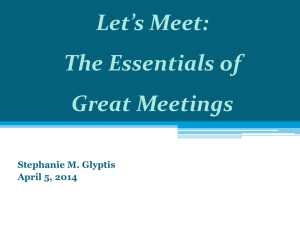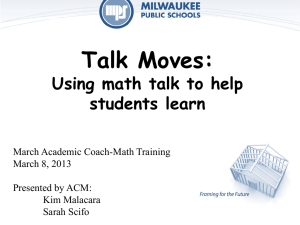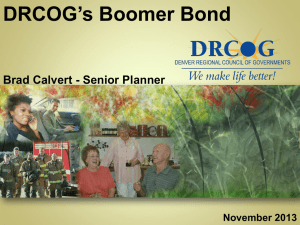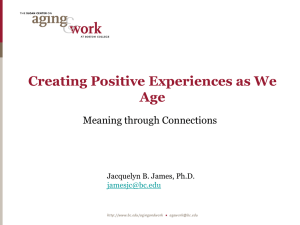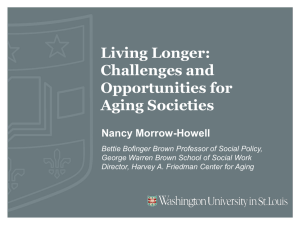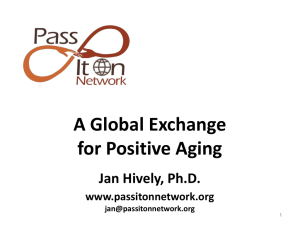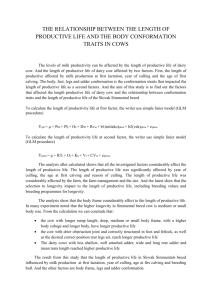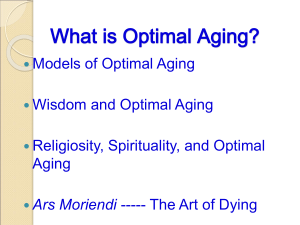Providing Meaningful Occupation for Older Adults with Physical
advertisement
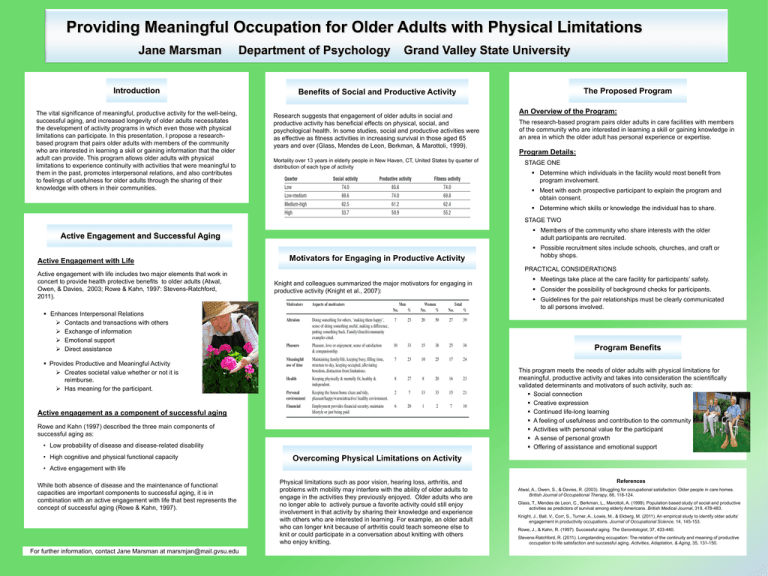
Providing Meaningful Occupation for Older Adults with Physical Limitations Jane Marsman Department of Psychology Introduction The vital significance of meaningful, productive activity for the well-being, successful aging, and increased longevity of older adults necessitates the development of activity programs in which even those with physical limitations can participate. In this presentation, I propose a researchbased program that pairs older adults with members of the community who are interested in learning a skill or gaining information that the older adult can provide. This program allows older adults with physical limitations to experience continuity with activities that were meaningful to them in the past, promotes interpersonal relations, and also contributes to feelings of usefulness for older adults through the sharing of their knowledge with others in their communities. Grand Valley State University The Proposed Program Benefits of Social and Productive Activity Research suggests that engagement of older adults in social and productive activity has beneficial effects on physical, social, and psychological health. In some studies, social and productive activities were as effective as fitness activities in increasing survival in those aged 65 years and over (Glass, Mendes de Leon, Berkman, & Marottoli, 1999). An Overview of the Program: The research-based program pairs older adults in care facilities with members of the community who are interested in learning a skill or gaining knowledge in an area in which the older adult has personal experience or expertise. Program Details: Mortality over 13 years in elderly people in New Haven, CT, United States by quarter of distribution of each type of activity STAGE ONE Determine which individuals in the facility would most benefit from program involvement. Meet with each prospective participant to explain the program and obtain consent. Determine which skills or knowledge the individual has to share. STAGE TWO Members of the community who share interests with the older adult participants are recruited. Active Engagement and Successful Aging Active Engagement with Life Active engagement with life includes two major elements that work in concert to provide health protective benefits to older adults (Atwal, Owen, & Davies, 2003; Rowe & Kahn, 1997: Stevens-Ratchford, 2011). Motivators for Engaging in Productive Activity PRACTICAL CONSIDERATIONS Knight and colleagues summarized the major motivators for engaging in productive activity (Knight et al., 2007): Meetings take place at the care facility for participants’ safety. Consider the possibility of background checks for participants. Guidelines for the pair relationships must be clearly communicated to all persons involved. Enhances Interpersonal Relations Contacts and transactions with others Exchange of information Emotional support Direct assistance Program Benefits Provides Productive and Meaningful Activity Creates societal value whether or not it is reimburse. Has meaning for the participant. This program meets the needs of older adults with physical limitations for meaningful, productive activity and takes into consideration the scientifically validated determinants and motivators of such activity, such as: Social connection Creative expression Continued life-long learning A feeling of usefulness and contribution to the community Activities with personal value for the participant A sense of personal growth Offering of assistance and emotional support Active engagement as a component of successful aging Rowe and Kahn (1997) described the three main components of successful aging as: • Low probability of disease and disease-related disability • High cognitive and physical functional capacity Possible recruitment sites include schools, churches, and craft or hobby shops. Overcoming Physical Limitations on Activity • Active engagement with life While both absence of disease and the maintenance of functional capacities are important components to successful aging, it is in combination with an active engagement with life that best represents the concept of successful aging (Rowe & Kahn, 1997). For further information, contact Jane Marsman at marsmjan@mail.gvsu.edu Physical limitations such as poor vision, hearing loss, arthritis, and problems with mobility may interfere with the ability of older adults to engage in the activities they previously enjoyed. Older adults who are no longer able to actively pursue a favorite activity could still enjoy involvement in that activity by sharing their knowledge and experience with others who are interested in learning. For example, an older adult who can longer knit because of arthritis could teach someone else to knit or could participate in a conversation about knitting with others who enjoy knitting. References Atwal, A., Owen, S., & Davies, R. (2003). Struggling for occupational satisfaction: Older people in care homes. British Journal of Occupational Therapy, 66, 118-124. Glass, T., Mendes de Leon, C., Berkman, L., Marottoli, A. (1999). Population based study of social and productive activities as predictors of survival among elderly Americans. British Medical Journal, 319, 478-483. Knight, J., Ball, V., Corr, S., Turner, A., Lowis, M., & Ekberg, M. (2011). An empirical study to identify older adults’ engagement in productivity occupations. Journal of Occupational Science, 14, 145-153. Rowe, J., & Kahn, R. (1997). Successful aging. The Gerontologist, 37, 433-440. Stevens-Ratchford, R. (2011). Longstanding occupation: The relation of the continuity and meaning of productive occupation to life satisfaction and successful aging. Activities, Adaptation, & Aging, 35, 131-150.
